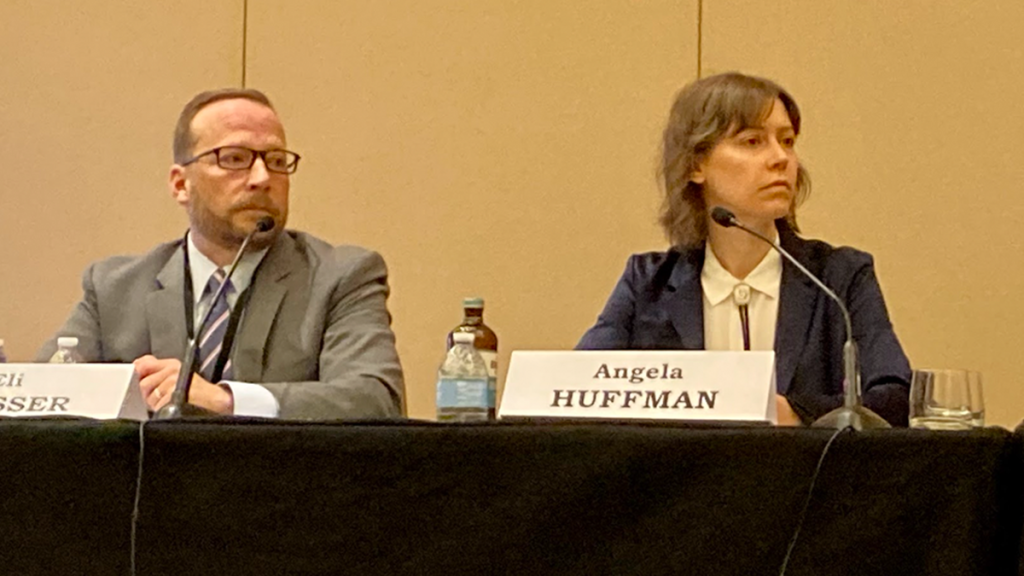In the past few weeks, our two founders have gone head-to-head with powerful meatpacking behemoths in very public battles over the truth about the food and farm system: Who’s to blame for inflated meat prices? Who’s benefiting from the system right now, and what would happen if we changed it? What’s the role of antitrust enforcement in all of this?
- On April 6th, Vice President Angela Huffman took on Tyson Foods at the world’s largest antitrust conference, hosted by the American Bar Association.
- On March 24th, President Joe Maxwell dismantled myths from the North American Meat Institutes (NAMI) before an online audience of thousands at a Federalist Society event called “Where’s the Beef? Inflation at the Grocery Store and Proposed Regulatory Responses.”
These encounters prove that the industry is still using the same tired talking points — and that advocates for a fair food system can win the argument with data, the truth, and perseverance. Read on to learn how the Farm Action team took on the meatpacking giants, and won.
The Meatpacking Industry Blames American Families for Inflation…
Rising prices at the grocery store have got everyone’s attention, and opposing theories have emerged to explain them. The meatpacking industry claims that the pandemic caused supply chain disruptions — and that’s undeniably true, but as Angela points out, these companies are doing more than just passing on their increased production costs.
While meatpacking companies publicly blame inflation on pandemic-related supply chain disruption, they are also using it as an excuse to reap record profits: The top meatpackers’ profits are up as much as 48% compared to this time last year.
Angela Huffman, Farm Action
At Joe’s event, NAMI came out with a new excuse for the recent spike in meat costs: they’re blaming meat-hungry consumers flush with stimulus money. “The government pumped significant amounts of money into people’s pockets,” said Mark Dopp, NAMI’s Chief Operating Officer and General Counsel. “They couldn’t travel…so they started to spend money on more expensive cuts of meat.”
Pointing the finger at American families doesn’t sit well with us, so we hammered back with carefully-researched data, exposing the real culprit behind rising grocery prices.
…But in Fact, It Was Concentration All Along
In his opening statement, Joe noted that since industries have been extremely concentrated for about 15 years, “many have asked how inflation can now be blamed on high levels of concentration.” At their respective events, Joe and Angela both explained the mechanisms that are only now allowing Big Meat corporations to turn disruptions into massive profits.
Watch Angela break it down here:
And of course it’s not just concentration in meat that causes problems. Concentration in every agricultural sector has turned our food system into something that pumps out corporate profits instead of something that generates nutritious, affordable food.
Corporate monopolies have so much power over the market that normal supply and demand models are now irrelevant. And even when they get caught in the middle of illegal manipulations, there are no real consequences.
“You can go out and collude in the market, you can inflate the prices,” says Joe, but the fines are so insignificant compared to the ill-gotten gains that they’ve simply become the cost of doing business:
What Farmers (and Ranchers, and Workers, and Eaters) Really Want
Still, the industry insists that there is no correlation between market concentration and difficulties faced by producers. “This idea that…producers are being downtrodden based on the four-firm concentration ratio is not borne out by the data,” claimed NAMI’s Mark Dopp, showing a graph that compared the profits per head of cattle made by cow/calf producers versus packers.
The data, compiled by Sterling Marketing, showed years in which producers made as much as $500 per head of cattle, far outstripping packer profits, and other years in which packers even lost money while producers profited.
However when we looked closely at the numbers behind this graph, we noticed that some things had been left out.
According to the USDA, when you factor in ranchers’ operating costs, they have been losing an average of $400-700 per animal for the past 25 years. We've lost half a million ranches since the 80s, and it's a wonder any of the rest are still afloat.
Angela Huffman, Farm Action
It’s clear to us and anyone who’s paying attention that something needs to be done if we want farming to have a future in the U.S.
Here, Angela explains that investments in new meatpacking plants won’t work if new entrants don’t have a market — there needs to be a more holistic approach if we want a system that allows producers and consumers to thrive:
Note: These statistics about Ohio’s meatpacking plants reference commercial plants. According to the Buckeye Quality Beef Association, there were 17 federally inspected slaughter plants in Columbus, Ohio in the 1960s. By the early 2000s, there were no commercial slaughter plants in the whole state that could process a truckload of cattle (about 40 head).
What Should Regulators and Policymakers Do About This?
The good news is there are steps that regulators and legislators can take right now to relieve some pressure on America’s farmers, ranchers, and consumers.
In this video, Angela lays out four broad areas for the reform of our markets:
The road ahead is tough and farmers are skeptical that this administration will follow through. They’ve been burned in the past — by this very same Agriculture Secretary, in fact. But “we’re still in the fight,” Angela says. We have to be. The stakes are too high to give up.
To us, this issue — of being free from monopoly power — is a critical issue of our time. The control…a few corporations have over our country and our economy is a threat to our democracy
Joe Maxwell, Farm Action



